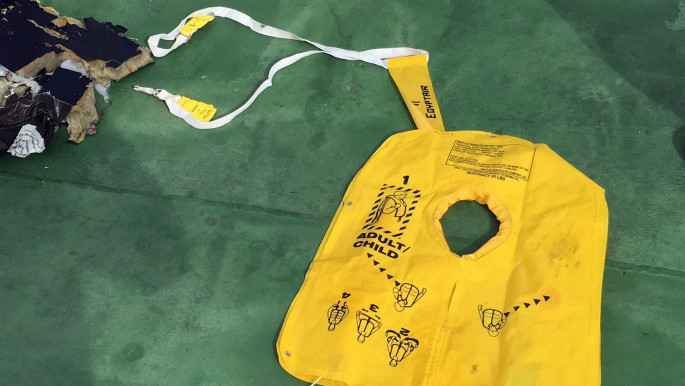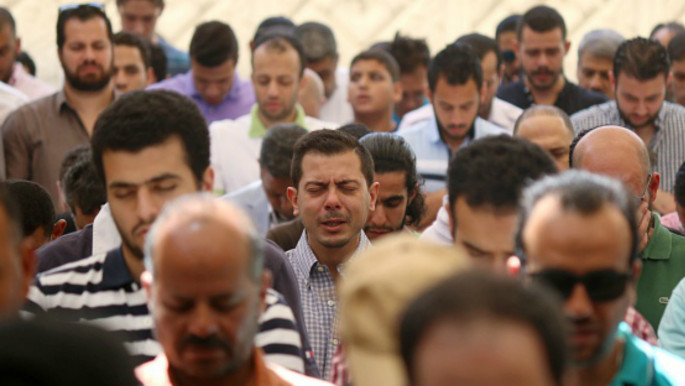Egypt releases images of plane wreckage following smoke reports
from the EgyptAir A320 that crashed into the Mediterranean with 66 people aboard, after earlier reports showed that the plane had transmitted automatic messages indicating smoke in the cabin.
The latest updates come as search crews scoured for more wreckage and black boxes for clues over why the plane plummeted and turned full circle before disappearing off radar.
"There were ACAR messages emitted by the plane indicating that there was smoke in the cabin shortly before data transmission broke off," a spokesman of France's Bureau of Investigations and Analysis told AFP.
ACAR, which stands for Aircraft Communications Addressing and Reporting System, is a digital system that transmits short messages between aircraft and ground stations.
The spokesman said it was "far too soon to interpret and understand the cause of Thursday's accident as long as we have not found the wreckage or the flight data recorders."
Automated warning messages were transmitted about three minutes before air traffic controllers lost contact with the plane at 0029 GMT on Thursday, a report by the Wall Street Journal said.
The warning messages indicated smoke in the nose of the aircraft and an apparent problem with the flight control system.
The messages indicated intense smoke in the front portion of the plane, specifically the lavatory and the equipment compartment beneath the cockpit.
The error warnings also indicated that the flight control computer malfunctioned, the report added.
No conclusions yet
Meanwhile, search teams continued to scour the Mediterranean for more wreckage and clues on Saturday.
The search focused on finding the bodies of passengers and the Airbus A320's flight recorders, which will stop emitting a signal in a month when the batteries run out.
French investigators met their Egyptian counterparts in Cairo, while a French patrol boat carrying equipment capable of tracing the plane's black boxes is expected on Sunday or Monday.
Meanwhile, Egypt's aviation minister pointed to terrorism as more likely than technical failure as investigators pored over the passenger list and questioned ground crew members at Charles de Gaulle Airport in Paris, where the plane took off.
But there was still "absolutely no indication" of why the plane went down," French foreign minister Jean-Marc Ayrault said, "We're looking at all possibilities."
Philip Baum, the editor of Aviation Security International Magazine, told the BBC that technical failure could not be ruled out.
"There was smoke reported in the aircraft lavatory, then smoke in the avionics bay, and over a period of three minutes the aircraft's systems shut down," he said.
 |
| Parts of the wreck of EgyptAir flight MS804 were seen in photos released by the Egyptian military on Saturday [Anadolu] |
"That's starting to indicate that it probably wasn't a hijack, it probably wasn't a struggle in the cockpit, it's more likely a fire on board. Now whether that was a technical fire, a short circuit, or whether it was because a bomb went off on board, we don't know."
Greek civil aviation chief Constantinos Litzerakos said the pilot had mentioned no problem in his last communication.
"The flight controllers contacted the pilot at a height of 37,000 feet... he did not mention a problem," he said.
The flight had been cruising normally in clear skies on a night-time flight to Cairo early Thursday when it suddenly lurched left, then right, spun all the way around and plummeted 38,000 feet [11,582.4 metres] into the sea, never issuing a distress signal.
The priority remains finding the passengers' bodies and the blackboxes, EgyptAir Holding Company chairman Safwat Molsem told AFP.
 |
| Relatives and friends of passengers of the EgyptAir plane that crashed in the Mediterranean pray at Abou Bakr el-Sedek mosque in Cairo [AFP] |
"The families want the bodies. That is what concerns us. The army is working on this. This is what we are focusing on," he said.
Relatives grieve
In Egypt, home to 30 of the victims, grieving families and friends wondered if their loved ones would ever be recovered.
Many gathered at a hotel near Cairo airport after meeting airline officials, as they struggled to come to terms with the catastrophe.
"They haven't died yet. No one knows. We're asking for God's mercy," said a woman in her 50s whose daughter had been on board.
Some congregated in mosques for Salat al-Ghaib, or "prayers for the absent," held for the dead whose bodies have not been found.
"This is what is ripping our hearts apart, when we think about it. When someone you love so much dies, at least you have a body to bury. But we have no body until now," said Sherif al-Metanawi, a childhood friend of the pilot, Mohammed Shoukair.
The passengers included 30 Egyptians, 15 French citizens, two Iraqis, two Canadians, and citizens from Algeria, Belgium, Britain, Chad, Portugal, Saudi Arabia and Sudan. They included a boy and two babies.
Seven crew members and three security personnel were also on board.
Agencies contributed to this report


![The White House Correspondents' dinner is seeing renewed scrutiny amid Israel's war in Gaza. [Brooke Anderson/The New Arab]](/sites/default/files/styles/image_330x185/public/2024-04/IMG_5497.jpg?h=71976bb4&itok=iSygAqbR)